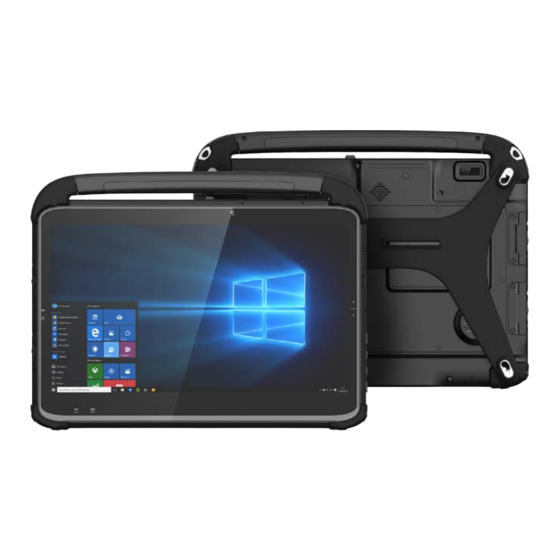Advertisement
Quick Links
Product End-of-Life Disassembly Instructions
Product Name / Model: DT Research Rugged Tablet / DT313Y
Purpose: The document is intended for use by end-of-life recyclers or treatment facilities. It provides the basic instructions
for the disassembly of DT Research products to remove components and materials requiring selective treatment, as
defined by EU Directive 2012/19/EU of the European Parliament and of the Council of 4 July 2012 on waste electrical and
electronic equipment (WEEE).
1.0 Items Requiring Selective Treatment
1.1 Items listed below are classified as requiring selective treatment.
1.2 Enter the quantity of items contained within the product which require selective treatment in the right column, as
applicable.
Item Description
Printed Circuit Boards Assemblies (PCBA)
Mass storage device
Batteries
Mercury-containing components
LCD Display
Cathode Ray Tubes (CRT)
Capacitors / condensers (Containing PCB/PCT)
Electrolytic Capacitors / Condensers measuring
greater than 2.5 cm in diameter or height
External electrical cables and cords
Gas Discharge Lamps
Plastics containing Brominated Flame Retardants
weighing > 25 grams (not including PCBs or PCAs
already listed as a separate item above)
Components and parts containing toner and ink,
including liquids, semi-liquids (gel/paste) and
toner
Components and waste containing asbestos
Components, parts and materials containing
refractory ceramic fibers
Components, parts and materials containing
radioactive substances
Notes
With a surface greater than 10 sq cm
Permanently soldered to PCBA
All types including standard alkaline and
lithium coin or button style batteries
For example, mercury in lamps, display
backlights, scanner lamps, switches,
batteries
a surface greater than 100 sq cm includes
background illuminated displays with gas
discharge lamps
Include the cartridges, print heads,
tubes, vent chambers, and service
stations.
Quantity of
items included
in product
1
0
2
0
1
0
0
0
1
0
0
0
0
0
0
Advertisement

Summary of Contents for DT Research DT313Y
- Page 1 Purpose: The document is intended for use by end-of-life recyclers or treatment facilities. It provides the basic instructions for the disassembly of DT Research products to remove components and materials requiring selective treatment, as defined by EU Directive 2012/19/EU of the European Parliament and of the Council of 4 July 2012 on waste electrical and electronic equipment (WEEE).
-
Page 2: Tools Required
2.0 Tools Required List the type and size of the tools that would typically be used to disassemble the product to a point where components and materials requiring selective treatment can be removed. Tool Description Tool Size (if applicable) Description #1 SCREW DRIVER(Plum flower head) Description #2 HAIR DRYER Description #3 KNIFE BLADE 3.0 Product Disassembly Process... - Page 3 (b) Dismantle the hand strap, handle and corners. (c) Remove batter pack and back cover ** Detailed steps for removing battery pack Slide the battery latch to the unlocked position. (ii) Lift the battery pack off the compartment.
- Page 4 (d) Remove the I/O door and back enclosure (e) Remove PCBA (f) Remove DC fan and thermal module...
- Page 5 (g) Remove camera module and speaker (h) Remove LCD Panel (i) Remove water-proof parts (O-ring)
- Page 6 (2) Dismantle the back enclosure (a) Remove smart card (b) Remove USB connectors (c) Remove buttons module...
- Page 7 (d) Dismantle mechanism of battery pack (e) Remove the antennas (3) Dismantle the back cover...
- Page 8 (4) Dismantle the I/O door (5) Dismantle the PCBA screws and disconnect the connecters (a) Bottom side of PCBA - Remove Gaskets and Shieldings (b) Bottom side of PCBA – Remove thermal pad...
- Page 9 (c) Top side of PCBA – Remove shielding and thermal pad.

















Need help?
Do you have a question about the DT313Y and is the answer not in the manual?
Questions and answers